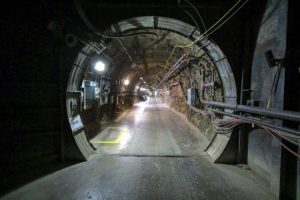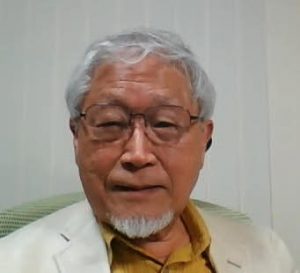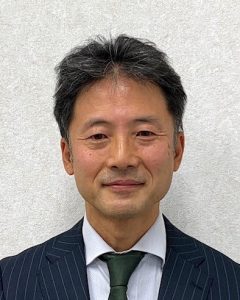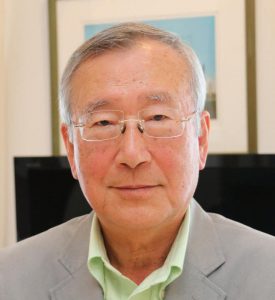Thoughts from Hiroshima: Views on U.S. subcritical nuclear test
Jun. 3, 2024
On May 17, it was learned that the United States had conducted a subcritical nuclear test at an underground nuclear test site in the U.S. western state of Nevada. The following day, voices of protest arose in unison from Hiroshima and Nagasaki. What lies behind the country’s carrying out a total of 34 nuclear tests not yielding a nuclear explosion? To realize a world in which no nation is reliant on nuclear weapons, what message should the A-bombed cities send to nuclear weapons states? The Chugoku Shimbun interviewed three experts in the hopes of using their diverse views as food for thought.
Call for breaking free of reliance on nuclear umbrella
Subcritical nuclear testing has three main purposes: (1) Maintain and manage nuclear arsenals; (2) Modernize nuclear weapons; (3) Prepare for resumption of nuclear tests that yield a nuclear explosion. The United States tends to emphasize (1), but we must never forget that the country is aiming at (2) and (3).
Modernization of nuclear weapons requires precise data obtainable through testing as well as enormous sums of money. The United States announced the recent test shortly after it had been conducted. The country could be trying to gain support from members of Congress and the public and secure resources by demonstrating domestically that it will maintain nuclear weapons in compliance with the Comprehensive Test Ban Treaty (CTBT), despite the fact that the country has yet to ratify the treaty.
The underground facility where subcritical nuclear tests have been conducted is located at the Nevada Test Site, where numerous explosive nuclear tests were once conducted. By maintaining the facility through its use for subcritical nuclear tests, the country is preparing to quickly resume explosive tests if and when necessary.
The CTBT is crucial for advancing nuclear disarmament and nuclear nonproliferation. While no provisions exist prohibiting subcritical nuclear testing, such tests clearly violate the spirit of the CTBT. Regardless, Japan’s national government does not protest the tests, a situation that results from the country’s reliance on the U.S. nuclear umbrella. If the U.S. government were to insist that the tests are to maintain the nuclear umbrella, the Japanese government would not have any standing to complain.
Voices were raised in the A-bombed cities in protest of the test. They are the same voices as those calling for the abolition of nuclear weapons. There should be more such voices. For example, local governments that have declared themselves to be nuclear-free should raise their voices and demand a halt to the tests. That would surely send a strong message. At the same time, it is important to continue to demand that the Japanese government oppose nuclear testing and free itself of the nuclear umbrella. (Interviewed by Kana Kobayashi, Staff Writer)
Hiromichi Umebayashi completed a doctoral degree in engineering at the University of Tokyo. After working as a university professor, among other positions, he established Peace Depot in 1998. He also served as the first director of the Research Center for Nuclear Weapons Abolition at Nagasaki University.
Criticism does not aid progress for CTBT
Naturally, subcritical nuclear tests attract criticism, given the ideal of the immediate elimination of nuclear weapons as well as the wishes of A-bomb survivors. At the same time, I want to take this opportunity to consider the issue from a different perspective.
The United States maintains the reliability of its nuclear weapons based on the Stockpile Stewardship Plan (SSP) and other programs for which subcritical nuclear testing serves as a core.
Japan and other U.S. allies rely on the U.S. nuclear umbrella, and there is no denying the possibility that some countries might consider possessing their own nuclear weapons if the “reliability” of the U.S. nuclear umbrella was ever brought into question. Such a situation would reverse gains made in the areas of nuclear disarmament and non-proliferation.
In the United States, the Congress has yet to ratify the CTBT due to profound concerns that the reliability of its nuclear weapons cannot be maintained without underground nuclear testing. In consideration of such concerns, the CTBT was established with no prohibition of tests without an explosion. Those promoting the treaty emphasize that the SSP allows for nuclear weapons to be maintained without resumption of explosive tests. Criticism of subcritical nuclear testing does not positively affect the aim of having the CTBT enter into force.
Even among nuclear powers, China and Russia are far worse in terms of transparency about information. The United States takes offense that it, the only nation that discloses such information, is the one to undergo criticism as it was this time. Transparency could once again be harmed, as happened during the Trump administration.
The biggest concern is that China and Russia might resume explosive tests. China in particular is believed to have a strong desire to test small, low-yield nuclear weapons. One intent behind the release of information by the United States about its recent test was to prompt China and Russia to also disclose such information.
If the norm of a ban on explosive testing among the world’s major powers is ever violated, it would impact North Korea, leaving Japan’s security threatened. In addition to their original appeals, the A-bombed cities should call for the entry into force of the CTBT, sending a message that they continue to keep an eye on the movements of all nuclear weapons states. (Interviewed by Yumi Kanazaki)
Michiru Nishida majored in nonproliferation studies at the Middlebury School of International Studies at Monterey, in the United States. He obtained a doctorate in law at Hitotsubashi University. Before assuming his current post, he served in the Arms Control and Disarmament Division of Japan’s Ministry of Foreign Affairs, the Delegation of Japan to the Conference on Disarmament in Geneva, and the Embassy of Japan in the United States.
Draw line between city and national government, convey voices from A-bombed city
When I was mayor of Hiroshima, I sent a letter of protest to the leaders of countries each time I learned they had conducted a subcritical nuclear test. Subcritical nuclear tests are intended to maintain and strengthen the nuclear regime. It is the responsibility of the A-bombed city to continue applying pressure on the nuclear weapons states by communicating its message. Even if immediately changing the behavior of the nuclear weapons states is difficult, we must never give up on that possibility.
It is vital that the city not only make appeals to the countries that have conducted the tests but also visibly share with its citizens its will to never accept such testing. For instance, before its renovation in 2017, the Hiroshima Peace Memorial Museum, located in the city’s Naka Ward, displayed many letters of protest from former mayors, including those expressing opposition to explosive tests, in its East Building.
Stopping the tests is an important condition for the elimination of nuclear weapons. But that alone is insufficient for achieving that objective. I hope we can also continue to make concrete efforts.
One of those efforts is to encourage nuclear weapons states to adopt a “no first use” policy, by which they would declare their intent to never be the first to use nuclear weapons, and to broaden support for this policy among their allies. If all nuclear weapons states were to determine not to use nuclear weapons first, the risk of use of the weapons would immediately fall. The role of nuclear weapons would be diminished, which would create an environment conducive to nuclear disarmament and abolition. The targets of nuclear attacks by a nuclear power are cities. It would be highly significant for cities to advocate for the “no first use” policy.
Japan’s national government does not oppose subcritical nuclear testing and continues to turn its back on the Treaty on the Prohibition of Nuclear Weapons (TPNW), which is interpreted as prohibiting non-explosive tests. The Japanese government should be taking the lead in promoting the treaty, but instead it is playing the role of flag waver for rendering the treaty powerless. The Hiroshima City government must draw a line between itself and the Prime Minister’s Office and the Ministry of Foreign Affairs and deliver to Japan and the rest of the world the voices of the A-bombed city, which are different from that of the Japanese government. How do matters stand today? The stance of the A-bombed city is also being called into question. (Interviewed by Kana Kobayashi)
Tadatoshi Akiba obtained a doctorate from the Massachusetts Institute of Technology, in the United States. After serving as an associate professor at Tufts University, professor at Hiroshima Shudo University, and member of Japan’s House of Representatives, he served as mayor of Hiroshima for three terms starting in 1999. He is currently a representative member of the Hiroshima prefectural chapter of the Japan Congress against A- and H-Bombs.
Keywords
Comprehensive Test Ban Treaty
The Comprehensive Test Ban Treaty (CTBT) prohibits nuclear tests that yield an explosion from being conducted anywhere, including in outer space, the atmosphere, underwater, and underground. It was adopted by the United Nations in 1996 and has been ratified by 178 countries. To enter into force, the treaty must be ratified by the 44 nations that possessed nuclear reactors at the time the treaty was being negotiated. The United States, China, Egypt, Iran, and Israel have yet to ratify the treaty, and India, Pakistan, and North Korea have still not signed it. Russia withdrew its ratification in November 2023. Japan ratified the treaty in 1997. While the CTBT has yet to come into effect, the headquarters of the Preparatory Commission for the Comprehensive Test Ban Treaty Organization, located in Vienna, has established a network to monitor and detect nuclear explosive tests conducted around the world.
(Originally published on June 3, 2024)
Hiromichi Umebayashi, 86, special advisor to Peace Depot, a non-profit organization
Call for breaking free of reliance on nuclear umbrella
Subcritical nuclear testing has three main purposes: (1) Maintain and manage nuclear arsenals; (2) Modernize nuclear weapons; (3) Prepare for resumption of nuclear tests that yield a nuclear explosion. The United States tends to emphasize (1), but we must never forget that the country is aiming at (2) and (3).
Modernization of nuclear weapons requires precise data obtainable through testing as well as enormous sums of money. The United States announced the recent test shortly after it had been conducted. The country could be trying to gain support from members of Congress and the public and secure resources by demonstrating domestically that it will maintain nuclear weapons in compliance with the Comprehensive Test Ban Treaty (CTBT), despite the fact that the country has yet to ratify the treaty.
The underground facility where subcritical nuclear tests have been conducted is located at the Nevada Test Site, where numerous explosive nuclear tests were once conducted. By maintaining the facility through its use for subcritical nuclear tests, the country is preparing to quickly resume explosive tests if and when necessary.
The CTBT is crucial for advancing nuclear disarmament and nuclear nonproliferation. While no provisions exist prohibiting subcritical nuclear testing, such tests clearly violate the spirit of the CTBT. Regardless, Japan’s national government does not protest the tests, a situation that results from the country’s reliance on the U.S. nuclear umbrella. If the U.S. government were to insist that the tests are to maintain the nuclear umbrella, the Japanese government would not have any standing to complain.
Voices were raised in the A-bombed cities in protest of the test. They are the same voices as those calling for the abolition of nuclear weapons. There should be more such voices. For example, local governments that have declared themselves to be nuclear-free should raise their voices and demand a halt to the tests. That would surely send a strong message. At the same time, it is important to continue to demand that the Japanese government oppose nuclear testing and free itself of the nuclear umbrella. (Interviewed by Kana Kobayashi, Staff Writer)
Hiromichi Umebayashi completed a doctoral degree in engineering at the University of Tokyo. After working as a university professor, among other positions, he established Peace Depot in 1998. He also served as the first director of the Research Center for Nuclear Weapons Abolition at Nagasaki University.
Michiru Nishida, 52, professor, School of Global Humanities and Social Sciences, Nagasaki University
Criticism does not aid progress for CTBT
Naturally, subcritical nuclear tests attract criticism, given the ideal of the immediate elimination of nuclear weapons as well as the wishes of A-bomb survivors. At the same time, I want to take this opportunity to consider the issue from a different perspective.
The United States maintains the reliability of its nuclear weapons based on the Stockpile Stewardship Plan (SSP) and other programs for which subcritical nuclear testing serves as a core.
Japan and other U.S. allies rely on the U.S. nuclear umbrella, and there is no denying the possibility that some countries might consider possessing their own nuclear weapons if the “reliability” of the U.S. nuclear umbrella was ever brought into question. Such a situation would reverse gains made in the areas of nuclear disarmament and non-proliferation.
In the United States, the Congress has yet to ratify the CTBT due to profound concerns that the reliability of its nuclear weapons cannot be maintained without underground nuclear testing. In consideration of such concerns, the CTBT was established with no prohibition of tests without an explosion. Those promoting the treaty emphasize that the SSP allows for nuclear weapons to be maintained without resumption of explosive tests. Criticism of subcritical nuclear testing does not positively affect the aim of having the CTBT enter into force.
Even among nuclear powers, China and Russia are far worse in terms of transparency about information. The United States takes offense that it, the only nation that discloses such information, is the one to undergo criticism as it was this time. Transparency could once again be harmed, as happened during the Trump administration.
The biggest concern is that China and Russia might resume explosive tests. China in particular is believed to have a strong desire to test small, low-yield nuclear weapons. One intent behind the release of information by the United States about its recent test was to prompt China and Russia to also disclose such information.
If the norm of a ban on explosive testing among the world’s major powers is ever violated, it would impact North Korea, leaving Japan’s security threatened. In addition to their original appeals, the A-bombed cities should call for the entry into force of the CTBT, sending a message that they continue to keep an eye on the movements of all nuclear weapons states. (Interviewed by Yumi Kanazaki)
Michiru Nishida majored in nonproliferation studies at the Middlebury School of International Studies at Monterey, in the United States. He obtained a doctorate in law at Hitotsubashi University. Before assuming his current post, he served in the Arms Control and Disarmament Division of Japan’s Ministry of Foreign Affairs, the Delegation of Japan to the Conference on Disarmament in Geneva, and the Embassy of Japan in the United States.
Tadatoshi Akiba, 81, former Hiroshima City mayor
Draw line between city and national government, convey voices from A-bombed city
When I was mayor of Hiroshima, I sent a letter of protest to the leaders of countries each time I learned they had conducted a subcritical nuclear test. Subcritical nuclear tests are intended to maintain and strengthen the nuclear regime. It is the responsibility of the A-bombed city to continue applying pressure on the nuclear weapons states by communicating its message. Even if immediately changing the behavior of the nuclear weapons states is difficult, we must never give up on that possibility.
It is vital that the city not only make appeals to the countries that have conducted the tests but also visibly share with its citizens its will to never accept such testing. For instance, before its renovation in 2017, the Hiroshima Peace Memorial Museum, located in the city’s Naka Ward, displayed many letters of protest from former mayors, including those expressing opposition to explosive tests, in its East Building.
Stopping the tests is an important condition for the elimination of nuclear weapons. But that alone is insufficient for achieving that objective. I hope we can also continue to make concrete efforts.
One of those efforts is to encourage nuclear weapons states to adopt a “no first use” policy, by which they would declare their intent to never be the first to use nuclear weapons, and to broaden support for this policy among their allies. If all nuclear weapons states were to determine not to use nuclear weapons first, the risk of use of the weapons would immediately fall. The role of nuclear weapons would be diminished, which would create an environment conducive to nuclear disarmament and abolition. The targets of nuclear attacks by a nuclear power are cities. It would be highly significant for cities to advocate for the “no first use” policy.
Japan’s national government does not oppose subcritical nuclear testing and continues to turn its back on the Treaty on the Prohibition of Nuclear Weapons (TPNW), which is interpreted as prohibiting non-explosive tests. The Japanese government should be taking the lead in promoting the treaty, but instead it is playing the role of flag waver for rendering the treaty powerless. The Hiroshima City government must draw a line between itself and the Prime Minister’s Office and the Ministry of Foreign Affairs and deliver to Japan and the rest of the world the voices of the A-bombed city, which are different from that of the Japanese government. How do matters stand today? The stance of the A-bombed city is also being called into question. (Interviewed by Kana Kobayashi)
Tadatoshi Akiba obtained a doctorate from the Massachusetts Institute of Technology, in the United States. After serving as an associate professor at Tufts University, professor at Hiroshima Shudo University, and member of Japan’s House of Representatives, he served as mayor of Hiroshima for three terms starting in 1999. He is currently a representative member of the Hiroshima prefectural chapter of the Japan Congress against A- and H-Bombs.
Keywords
Comprehensive Test Ban Treaty
The Comprehensive Test Ban Treaty (CTBT) prohibits nuclear tests that yield an explosion from being conducted anywhere, including in outer space, the atmosphere, underwater, and underground. It was adopted by the United Nations in 1996 and has been ratified by 178 countries. To enter into force, the treaty must be ratified by the 44 nations that possessed nuclear reactors at the time the treaty was being negotiated. The United States, China, Egypt, Iran, and Israel have yet to ratify the treaty, and India, Pakistan, and North Korea have still not signed it. Russia withdrew its ratification in November 2023. Japan ratified the treaty in 1997. While the CTBT has yet to come into effect, the headquarters of the Preparatory Commission for the Comprehensive Test Ban Treaty Organization, located in Vienna, has established a network to monitor and detect nuclear explosive tests conducted around the world.
(Originally published on June 3, 2024)











